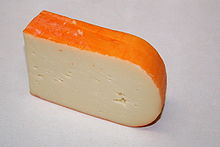Mahón cheese: Difference between revisions
m Renamed per RM outcome., replaced: Minorca → Menorca (6) using AWB |
Rescuing 1 sources and tagging 0 as dead. #IABot (v1.6.1) |
||
| Line 20: | Line 20: | ||
== Production == |
== Production == |
||
Nearly a century ago, the gatherer-ripeners were said to have emerged as a class of island society in [[Menorca]].<ref name=Guide>{{cite news | author= | title=The Taste of Menorca: Mahon |
Nearly a century ago, the gatherer-ripeners were said to have emerged as a class of island society in [[Menorca]].<ref name=Guide>{{cite news | author= | title=The Taste of Menorca: Mahon | url=http://www.cheesefromspain.com/CFS/1503Mahon_I.htm | work=Cheese from Spain | year=2009 | accessdate=2009-11-19 | deadurl=yes | archiveurl=https://web.archive.org/web/20091006011544/http://www.cheesefromspain.com/CFS/1503Mahon_I.htm | archivedate=2009-10-06 | df= }}</ref> Their work consisted of trading and distributing farm products, seeds, utensils, foods, etc. In exchange they would receive fresh cheeses that the farmers brought to their houses. In order to store them, the ''recogedores'' had underground caves for the careful and novel aging of the cheeses. They controlled everything in production, from the changing winds and temperature level to the correct handling of the product. In so doing, they obtained the original cheese from Mahón; soft, aired or cured, that they would then sell in diverse markets of the islands and the peninsula. Their careful techniques made famous Mahón cheese, and helped to make it a sought after export.<ref name=Guide/> |
||
Recently, [[Menorca]]'s live-stocks of cattle have well designed health and genetic selection, with one of the largest milk productions in Spain in more than 600 farms. This milk is totally used for dairy products.<ref name=Guide/> |
Recently, [[Menorca]]'s live-stocks of cattle have well designed health and genetic selection, with one of the largest milk productions in Spain in more than 600 farms. This milk is totally used for dairy products.<ref name=Guide/> |
||
Revision as of 06:36, 13 January 2018
| Mahón, Maó hallo | |
|---|---|
 | |
| Other names | Mahón-Menorca, Maó |
| Country of origin | Spain |
| Region | Balearic Islands, Spain |
| Town | Menorca, Mahón |
| Source of milk | Cows |
| Texture | Soft to hard |
| Dimensions | 20cm x 20cm x 9cm |
| Weight | 2-3kg |
| Aging time | 3 weeks-2 years or longer[1] |
| Certification | DOP 1985 |
Mahón cheese is a soft to hard white cheese made from cow's milk, named after the natural port of Mahón on the island of Menorca off the Mediterranean coast of Spain. Menorca is known for its cheese production and is home to one of the most respected dairy plants in Europe.[1]
Production
Nearly a century ago, the gatherer-ripeners were said to have emerged as a class of island society in Menorca.[2] Their work consisted of trading and distributing farm products, seeds, utensils, foods, etc. In exchange they would receive fresh cheeses that the farmers brought to their houses. In order to store them, the recogedores had underground caves for the careful and novel aging of the cheeses. They controlled everything in production, from the changing winds and temperature level to the correct handling of the product. In so doing, they obtained the original cheese from Mahón; soft, aired or cured, that they would then sell in diverse markets of the islands and the peninsula. Their careful techniques made famous Mahón cheese, and helped to make it a sought after export.[2]
Recently, Menorca's live-stocks of cattle have well designed health and genetic selection, with one of the largest milk productions in Spain in more than 600 farms. This milk is totally used for dairy products.[2]
In 1985 the cheese from Mahón received the Denominación de Origen.
Characteristics

Mahón has some characteristics specific to it, despite aging. In general the cheese is buttery sharp, slightly salty and lightly aromatic (sweet and nutty aromas) in taste.
Mahón's sweet and fruity but at times slightly salty taste is due in part to the sea salt content in the grasses the cows eat.[citation needed] The rind is generally an orange color due to the rind being rubbed with butter, or oil, and paprika. As it reaches maturity (around 10 months) it tends to have small misshapen holes and has some granularity. In general, all aged Mahón has a proliferation of tiny holes.
Young (Artesano) Mahón
Artesano (Spanish for "artisanal") Mahón is young, aged no longer than three months, and softer than traditional Mahón. It is important to keep young Mahón in the vegetable compartment of a refrigerator or cooler. It should be stored in airtight plastic wrapping to preserve its softness.
Aged Mahón
Conversely, harder, more aged Mahón should be wrapped in foil or waxed paper.
Uses
- Mahón is considered one of the most versatile cheese of the Spanish gastronomy.
- The creamy texture suggests it be served over pasta, potato, rice and/or vegetable dishes.
- The traditional manner of eating Mahón consisted of sliced cheese, sprinkled with olive oil, black pepper and tarragon.
- Most of the production of this cheese is used to make processed cheese (queso fundido, not to be confused with the cheese dish of the same name).[3]
See also
References
- ^ a b Jenkins, Steven. 1996. Cheese Primer. New York: Workman Publishing Company, Inc. 186-188.
- ^ a b c "The Taste of Menorca: Mahon". Cheese from Spain. 2009. Archived from the original on 2009-10-06. Retrieved 2009-11-19.
{{cite news}}: Unknown parameter|deadurl=ignored (|url-status=suggested) (help) - ^ Fox, P. F. (ed.) (1999) Cheese: Chemistry, Physics and Microbiology (Major Cheese Groups) Springer. Google Books. Retrieved 11 October 2013.
